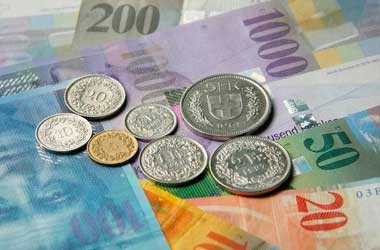 The Swiss franc climbed to 0.926 per US dollar, rebounding from a seven-month low of 0.937 per US dollar reached on November 24th, as investors fled to safety after the discovery of the new Covid-19 type on the market. As a result of its high potential infection rates and the fact that the vaccine’s consequences are yet unclear, investors expect that the new variation may hinder economic recovery.
The Swiss franc climbed to 0.926 per US dollar, rebounding from a seven-month low of 0.937 per US dollar reached on November 24th, as investors fled to safety after the discovery of the new Covid-19 type on the market. As a result of its high potential infection rates and the fact that the vaccine’s consequences are yet unclear, investors expect that the new variation may hinder economic recovery.
Nevertheless, the Swiss franc has continued to strengthen against the euro, reaching levels not seen in more than six years, as investors seek a safe haven investment against market uncertainty caused by the ongoing epidemic and inflationary pressure in the Euro Area. Switzerland’s gross domestic product increased by 1.7 percent quarter on quarter in the three months to September 2021, after a 1.8 percent increase in the previous period and falling short of market estimates of a 2 percent increase.
In the second quarter, private consumption declined (to 2.7 percent from a year earlier) and investment in building slowed (to 0.1 percent from a year earlier) while equipment and software investment fell (-1.3 percent vs 3.2 percent). Aside from that, government consumption declined (by 1.5 percent as opposed to 4.1 percent) and net external demand had a negative impact on GDP, with exports growing at a slower rate than imports. The economy grew 4.1 percent year on year in the third quarter, dropping from an 8.6 percent expansion in the previous quarter but still above expectations of 3.2 percent.
Over the third quarter of 2021, Switzerland’s non-farm payrolls increased by 1.5 percent from the previous year, reaching an all-time peak of 5.213 million, after having gained 1.0 percent during the preceding three-month period. With the relaxation of COVID-19 restrictions, employment in the service sector increased by 1.8 percent to 4.114 million, with gains in business-related services accounting for 3.5 percent of total employment, education accounting for 3.2 percent, health and social services accounting for 3.1 percent, financial services accounting for 1.3 percent, and transportation and communication accounting for 0.8 percent.
As a result of a rise in construction employment (0.5 percent), job creation in the industrial sector increased by 0.2 percent, somewhat offsetting a loss in manufacturing employment (-0.1 percent). As a result of a robust Swiss Franc, the investor sentiment index in Switzerland fell by 26.4 points in November of 2021, to -10.8 points, the lowest level since March of 2020. The index is expected to decrease further over the following six months as export momentum weakens.On the contrary, the present economic condition was rated 54.1 in November, up from 50 in October.
According to official figures, industrial production in Switzerland increased by 8.3 percent year on year in the third quarter of 2021, after a previously reported record 16.1 percent increase in the preceding three-month period. In spite of a slower pace, industrial activity increased for the third consecutive quarter, in large part as a result of diminishing low-base effects, which have faded in recent years.
Manufacturing output climbed at a slower rate (9.4 percent in Q2 compared to 17.3 percent in Q1), with most activities rising at a slower rate, with the exception of the production of pharmaceutical items, which grew at a faster rate (6.4 percent vs -2 percent). In addition, output declined in mining and quarrying (-0.6 percent compared to 16.7 percent) and power supply (-3.2 percent vs 4.2 percent). In the most recent quarter, industrial output fell 1.2 percent on a seasonally adjusted quarterly basis, after an upwardly corrected 1.2 percent increase in the preceding period.
From CHF 4.3 billion in the previous month, Switzerland’s trade surplus improved to CHF 4.4 billion in October 2021, marking an increase of 0.4 percent over the previous month. Exports decreased by 1.4 percent month on month, with sales of chemicals and pharmaceutical products (-2.8 percent), precision instruments (-2.4 percent), and cars (-1.4 percent) accounting for the majority of the decrease (-1.4 percent).
The unemployment rate in Switzerland decreased to 2.5 percent in October 2021, the lowest level since February 2020, according to non-seasonally adjusted data. The number of jobless persons decreased by 3,561, or 3.0 percent, to 116,733, according to the Bureau of Labor Statistics. Meanwhile, the youth unemployment rate (those seeking work between the ages of 15 and 24), which measures job-seekers aged 15 to 24, fell to a 27-month low of 2.1 percent from 2.4 percent in September, with the number of young jobless decreasing by 1,382, or 11.0 percent, to 11,171 people.
When seasonal variables are taken into consideration, the jobless rate decreased to 2.7 percent in October from 2.8 percent in September. According to the Swiss National Statistics Office, annual inflation in Switzerland increased to 1.2 percent in October of 2021 from 0.9 percent a month earlier, which was somewhat higher than the market forecast of 1.1 percent.
There has been a quicker increase in the cost of both transportation (7.3 percent compared to 6.2 percent in September) and housing and energy, which has resulted in the highest reading since August 2018. (2.7 percent vs 2.0 percent).




